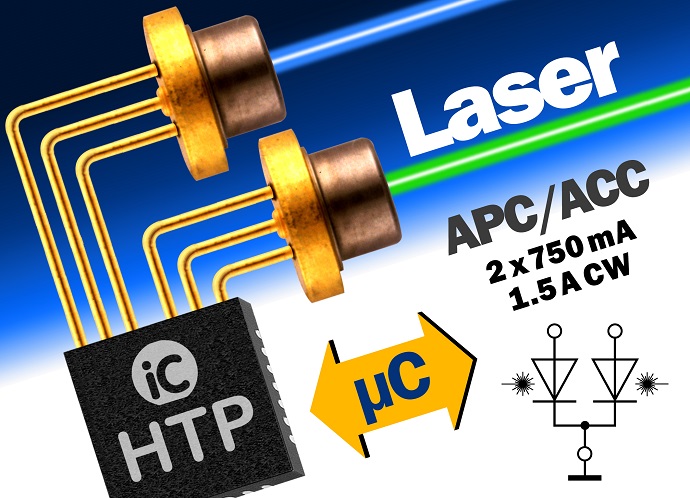June 19, 2015
The new laser diode driver iC-HTP permits microcontroller-based driving of laser diodes with common cathodes or P-type laser diodes in CW mode (Continuous Wave). With this device either Automatic Power Control (APC), Automatic Current Control (ACC), or a full controller-based power regulation can be used. For driving N-type and M-type laser diodes in CW mode, the similar laser diode driver iC-HT can be used. The maximum laser diode current per channel is 750 mA. Both channels can be connected in parallel for higher laser diode currents of up to 1.5 A. A current limit can also be configured for each channel. Due to the high integration level of the analog functions for driving the laser diodes with a microcontroller interface, multi-channel laser diode control units can be implemented directly. Apart from the iC-HTP only a microcontroller and laser diodes with different wavelengths, for example, are required.
Internal operating points and voltages can be output through analog/digital converters. The integrated temperature sensor permits the system temperature to be monitored and can also be used for feedback in the control circuit.
Logarithmic digital/analog converters allow optimal power regulation across a large dynamic range enabling a variety of laser diodes to be used.
The relevant configuration is stored in two equivalent memory areas; internal current limits, a supply voltage monitor, channel-specific interrupt switching inputs, and a watchdog secure the operation of the laser diodes through iC-HTP.
Alternatively, the device can be operated by pin configuration instead of the SPI or I2C interface, where external resistors define the APC performance targets.
An external supply voltage can be controlled through the current output DCO to reduce the system power dissipation to a minimum, such as in battery-operated devices or systems.
iC-HTP uses supply voltages of 2.8 to 11 V and can thereby drive both blue and green laser diodes. Operating temperatures range from -40 to +85 °C. The device is packaged in a 28-pin 5 mm x 5 mm QFN.
The design-in process is supported by ready-to-operate demo boards and software for evaluation with a PC.
Further information can be found at http://www.ichaus.com/iC-HTP














